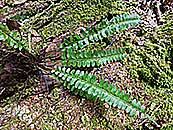Asplenium barteri hook.
Synonyms |
Asplenium lunulatum sw. var. barteri (Hook.) bonap. |
|---|---|
Common name |
|
Description |
Rhizome erect, short; rhizome scales dark brown, to 4 mm long, narrowly triangular in outline, apex abruptly narrowedinto a tapering point, margin pale brown with few hair-like lobes. Fronds monomorphic, tufted, pinnate, proliferous, subcoriaceous. Stipe 10–30 cm long, greyish, with few narrow, black scales to 3 mm long. Lamina ovate-lanceolate in outline, 14–30 x 4–6 cm, with 13-18 pairs of pinnae, basal pinnae not or only slightly reduced, apical pinnae abruptly narrowed into a linear lobed terminal pinna, at its base often proliferous; pinnae ovate or elliptic in outline, apex shortly tapering to point or rounded, base unequal, often slightly auriculate on the acroscopic side, margin slightly crenate-dentate, 2–4 x 0.5–1.2 cm, sessile, closely spaced; rhachis scaly; veins mostly simple, . Sori in 6–7 pairs on each side of the costa, at angle of 45°, 2–4 mm long; indusium linear, membranous, entire, 0.4–0.5 mm wide. |
Notes | A. barteri has pinnate, proliferous fronds; rhizome scales up to 4 mm long with marginal protuberances. |
Derivation | barteri: named after Charles Barter (1829/30-1859), foreman of the Regent's Park gardens of the Royal Botanic Society, London, was natural history collector on the second Niger expedition of William Balfour Baikie (1857-1859). |
Habitat | Moist forest, close to river, on schist. |
Distribution worldwide | See African distribution. |
Distribution in Africa |
Angola, Benin, Cameroon, Central African Republic, Congo, Dem. Republic of Congo, Equatorial Guinea (incl. Bioko), Gabon, Ghana, Guinea, Ivory Coast, Kenya, Liberia, Nigeria, Sierra Leone, Sudan and South Sudan, Tanzania , Uganda. |
Growth form |
Epiphytic. |
Literature |
|

